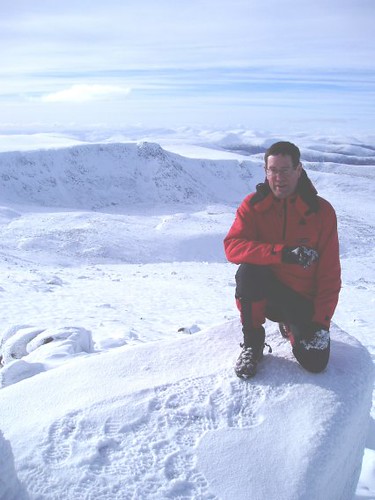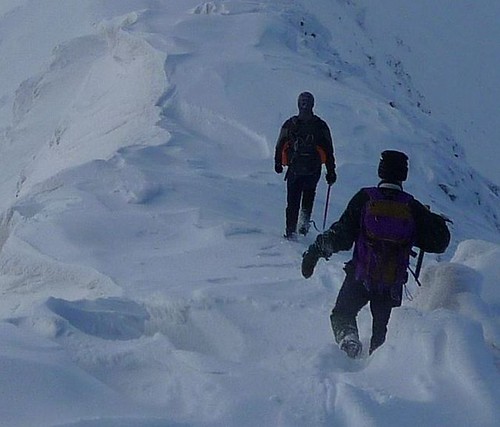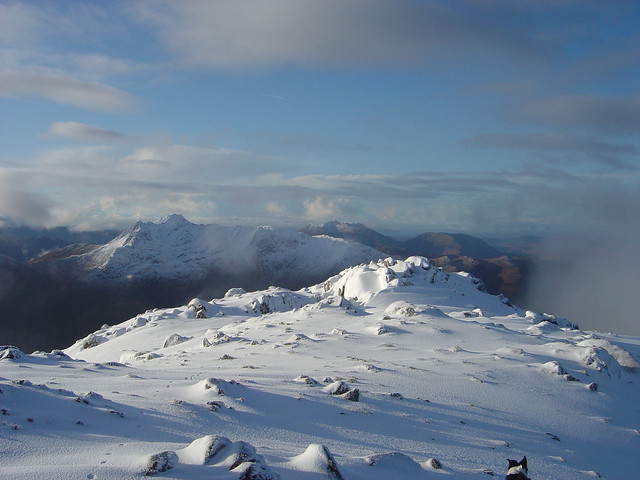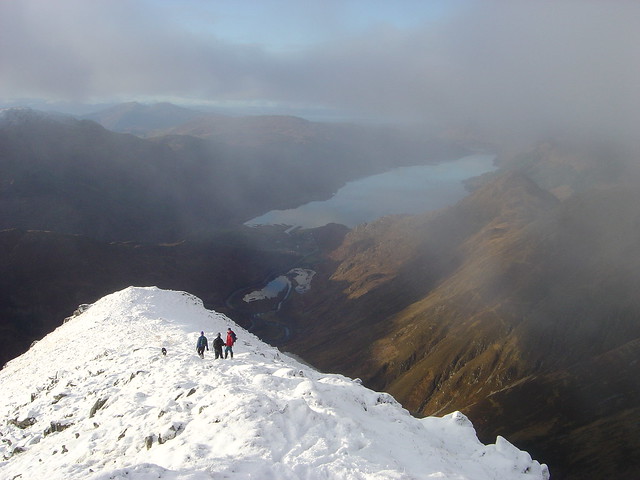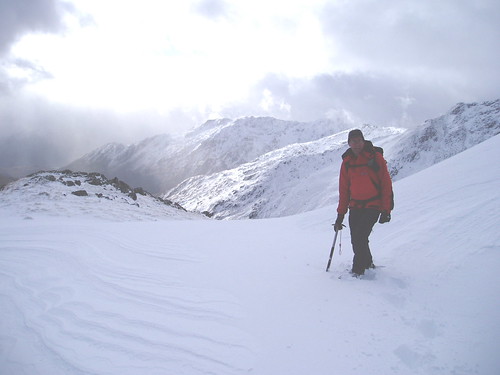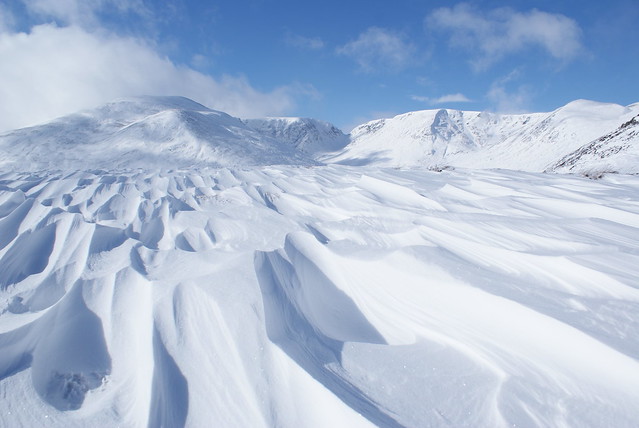- This topic has 95 replies, 40 voices, and was last updated 12 years ago by TandemJeremy.
-
Advice sought for a winter hillwalking beginner.
-
dhFree MemberPosted 13 years ago
Slightly OT, but one of the best tips I got was to make sure that your mobile is switched off when you are climbing, because if you get in the doo doo and do need to use it, you want full bars…
Not that you should rely on your phone of course.
This is also a good xmas read book Maybe to read in the bothy?
Off to crainlarich range this weekend for the first of this winter season, anyone know what the snow conditions are like up there?
Cheers
Dave
chutney13Free MemberPosted 13 years agoi’d make sure that you have some dry stuff that won’t get wet even if you have access other stuff. usually i have a small dry bag at the bottom of my rucksack with some thermals in and maybe a down vest.
dry bags are your friend as is a touch of ocd with packing up. if you are methodical it will help if things turn spiky. if i can return after a trip with everything tidy in my bag i am happy with myself. however usually if i’m on the last night everything just gets stuffed to deal with later which is not good if you get delayed another night.
i usually take some gaffer tape too.ditch_jockeyFree MemberPosted 13 years agoHad hoped to avoid taking courses, I prefer to learn by doing
Hope this doesn’t come across as patronising, and apologies in advance if it does, but I’m not aware of a course on winter walking that doesn’t involve ‘learning by doing’. The difference between having an experience and learning from experience is quite significant though. One of my old tutors used to say “practice doesn’t make perfect, it just makes permanent” – his point being that unless you have some way of processing an experience and correcting your practices and assumptions, practicing bad habits simply reinforces them.
A good course will give you a fast track way of being made aware of the basic techniques for protecting yourself with an axe and crampons – an experienced friend could do the same.
If you’re going to go down the bothy route, you still need to carry enough kit to be able to survive the night if you don’t make it to your destination, and back up critical stuff like your map and compass – I tend to use Memory Map printouts with a proper map in my pack in case I need it. If you want to get a sense of what you might find yourself dealing with, have a read of Cairngorm John which recounts several incidents where experienced people have found themselves in situations which rapidly spiralled out of their control.
None of this is intended to put you off – I love being in the hills in winter, and I’d absolutely encourage anyone else to get out there and have some fun too. But I’m under no illusions that there are occasions when relatively benign situations can transform into a real arse-clencher with frightening rapidity and that is not the time to be trying out something you read in a book for the first time. Even running through techniques at home is better than nothing – I quite often brush up on my rope work by setting up belays in the back garden and ‘abseiling’ down the stairs, especially if I haven’t been out for a while.
Again – apologies if this comes across as patronising in any way. Have fun – be safe 🙂
13thfloormonkFull MemberPosted 13 years agoNo, not patronising, perhaps I mis-typed though, I meant learning from accruing experience gradually, as opposed to just paying for a weekend’s course.
HOWEVER I now realise that’s impractical and yes, probably dangerous.
Good excuse to buy that Cairngorm’s John book, thanks for the recommendations dh and DJ
SandwichFull MemberPosted 13 years ago1:50k maps are better in snow as the extra detail a 1:25k provides is usually under snow/not visible due to white out. Navigation using map and compass and being able to use crampons and ice-axe are crucial skills. A good instructor will give you all the tools you need to get out and about safely. I can recommend the MCoS avalanche course that usually runs December/January time and is cheap and effective.
grittyshakerFree MemberPosted 13 years agoFor winter skills, if you are a student, you may be able to apply for a place on one of these subsidised courses:
http://www.thebmc.co.uk/News.aspx?id=3896
I notice the deadline has passed for this year but I did one over 15 years ago (so there likely to run next year). Really good value with top class instruction as I remember.
TandemJeremyFree MemberPosted 13 years agoBasic axe arrest can be taught easily if you know someone experienced – same with basic assessment of snow conditions. Its also good fun pissing about in the snow.
I taught myself to arrest using an axe with a couple of tips from people and books and then then going out and playing in the snow.
If what you are wanted to do is in the valleys then you don’t need all the axe and crampons skills – and I climbed many munros in winter before I got crampons anyway. I certainly would have an axe for arresting a fall to go on any steep slopes tho.
Its my favorite outdoor thing winter mountaineering. Nothing else comes close.
millcarFree MemberPosted 13 years agoSooo much good advice i have thought about bothering posting but…
I felt the same about courses but did do one and I’d probably not be exagerating to say its saved my bacon more than once. After the course i followed the advice on here (for climbing but same applies) by having fairly conservative goals, making mistakes, getting out of them, doing things better, doing longer days and so it goes on. Walked and climbed in cairngorms for three years before venturing onto more committing days on the Ben and hills of the northwest.
Not saying you should be quite so conservative but i guess you get the idea.
I’d also echo what others have said, the hills of Scotland in winter have been good to me giving me my most memorable outdoor days (and nights) Ive ever had. Some utter epics (27hr days, avalanches, crumbling snow, bone hard useless ice…) some awesome perfect days avalanches (creag megaidh last year on near perfect continous ice, walking across the Cairngorm plateau to the light of a full moon… this list is endless).
Get out and enjoy it and be safe doing it.
bullroarFree MemberPosted 13 years agoIt is worth remembering that the days are short and the distances often long (longer than you might think). In all probability you will be doing part of the route in the dark. Plan to do the dark bit in morning and get through any difficult ground/tricky navigation bits before it gets dark in the afternoon. Wandering around the Leanachan forest trying to find a parth back to the Gondola car park, to give a harmless example example, in the pitch black is not a good end to the day even with a headtorch.
druidhFree MemberPosted 13 years agoI ain’t reading all that 🙂
Some stuff I was thinking of…
Don’t assume that keeping to the glens is an easy option. Consider your worst peat hag nightmare and picture it covered in 3 feet of soft powder so you don’t know what’s solid and what isn’t. Walking along a wins-blasted hillside is often a better option.
Also – the glens can get colder due to temperature inversion.
Don’t assume you’ll find water easily (even in Scotland). It can be covered by snow or frozen hard.
10km per day doesn’t sound like very much – I’d be aiming for at least 16km. of course, you can get bogged down in snowdrifts, but you can also be speeding along on some nice nevé.
I always fancied trying snowshoes but never got around to it. Dunno if they can be rented.
If you are camping, make sure the tent is VERY steep sided so that snow doesn’t lie. Wet snow can stick to almost any surface and can build up quickly. A good 4-pole geodesic is the best option but too heavy for solo use. I like my Macpac Microlight as it can be pitched to avoid the worst of the wind and has the nice steep sides.
A tent which needs few pegging points is best as you might struggle if the snow is deep. Consider taking some snow stakes – even just a couple. use your axe and ski/walking pole as additional pegs and use two pegs at 90 degrees for additional stability.
A lightweight snow shovel can help build a sheltering wall and to prepare a flatter surface for pitching on. I have an alloy one which you slide onto the end of an ice axe as a handle. Let me know if you want to borrow it.
A silk liner will add a little extra comfort. I also have a polypropylene one which is a good deal warmer (but also heavier). Again, let me know if you want to borrow.
Keep an eye on your dew point. If it’s too close to your body (i.e. you have too much insulation close to you), frost can form inside your sleeping bag. Best to be just a little bit cold so that it forms on the tent instead.
Take a couple of good carrier bags and put your boots into them – and then inside your sleeping bag. This will stop them freezing overnight.
You will eat – and drink – loads. Take a bigger pot than usual and enough food. The long nights will likely see you having a few brews too. Think about how much extra gas you will need to cook all that.
I actually prefer liquid fuel during the winter, having had a few bad experiences with gas at low temperatures. If this is a first for you, practice lighting the stove at home first. With proper “Coleman” fuel and some priming jelly, it should all go pretty smoothly but there is still a greater risk of flame-out than with gas, so take care if cooking in the tent.
Set your alarm for midnight/1 am, get out and have a look around. If you are lucky, you’ll have a fantastic clear sky and beautiful bright snow all around you. It’s an experience you will never forget. I know some folk plan such trips for a full-moon just to enhance the experience. If the weather is pants, it serves as a good check on the conditions and you can check for drifting snow etc.
The Abhainn Rath can be a bugger of a crossing. I’d be taking a good pair of thick socks just to ford it – making sure that nothing else gets wet.
Is a course worthwhile? Absolutely! Get onto the Glenmore Lodge website asap 🙂
TandemJeremyFree MemberPosted 13 years agoGood words from Druidh – especially on the gas stoves. I would not rely on a gas stove in cold conditions again – trangia for me for the cold in future
B.A.NanaFree MemberPosted 13 years agoAswell as weather forecasts making or breaking your decisions. One of the key things that might cause you problems is low cloud over snow covered terrain causing a whiteout. Like someone says above, it renders the terrain indistiguishable. Personally, I’m not convinced about 1:50k maps making navigation any easier in these conditions. Micro navigating is not easy whatever map you have, it’s probably best to stick with the map size[?] you’re used to. You should be aware that batteries don’t work very well in the cold, so you need to be in a position to not rely on GPS. You can improve your ability to navigate in a whiteout by doing some featureless routes in the dark. Like TJ says, if you’re staying low, then snowcraft skills are less important, being confident to navigate in snow and poor vis, more so. Remember that you have much less light hours in winter and getting caught in difficult navigating conditions could slow your progress dramatically.
Saying this, don’t let the negitive stuff put you off, just make sensible decisions based on weather reports and the conditions expected. To me, what you are considering (solo, multi day, in winter) is a little bit more dangerous than going out with a bunch of mates on a single days high ridge walk. It may be completely irrational tho.paul4stonesFull MemberPosted 13 years agoSee if you can get hold of a copy of ‘Scotland’s Winter Mountains’ by Martin Moran. Seminal book IMO.
My friends and I have done the ‘learning by doing’ thing and so far we’re all here. Being sensible and aware of the potential dangers are as important as doing courses I’d say.
Ice axe is absolutely essential, before crampons but preferably with crampons. Make sure you know how to use them.
Don’t take so much stuff that you get knackered. Remember that generally going down will make a huge difference to conditions – we once ‘rescued’ a couple who were digging in for the night on Ben Nevis plateau because they were ‘lost’. You could clearly see the lights of Ft Bill and heading down just a couple of hundred metres made it much warmer and bearable.
I’ve camped in less than -10 and it’s fine with a decent bag but not in a storm. Join the MBA and find the fantastic bothies dotted about the place.
Enjoy yourself! I’m almost jealous of you in the position of starting this journey of exploration!
kennypFree MemberPosted 13 years agoWhat Druidh said except
practice lighting the stove at home first
No, practise in the garden first, not indoors (though in fairness he may have meant that).
buzz-lightyearFree MemberPosted 13 years agoReally enjoying this thread, it brings back great memories. Escaping an epic snowstorm on Kintail, benighting on Cairngorm, bluebird days in Torridon and Lochaber.
Someone start a new thread so I can hear about everyone’s epics.
druidhFree MemberPosted 13 years ago😀 at kennyp
Oh I have a copy of the Martin Moran book too if you want to borrow it Ian.
Edit: There BL – I’ve kept the thread alive!
B.A.NanaFree MemberPosted 13 years agoSee if you can get hold of a copy of ‘Scotland’s Winter Mountains’ by Martin Moran. Seminal book IMO.
I’ve already recommended that book, altho I’ve never read the massive chapter on interpreting weather maps. The instructional bit about interpreting SAIS reports was worth the purchase tho. I’d spent 5-7 years not knowing that almost every word is considered. As inexperienced youfs 20 years ago, We used to just look at the Avalanche grading and not bother much with the detailed text, so we often lost out on good days out.
jcaFull MemberPosted 13 years agoHate to agree with TJ, but practice using your axe. Knowing how to use it is very different to actually being able to. Even if you are sticking to valleys etc, you can still end up contouring snow covered slopes, where a slip is very easy to have. In summer if you lose your footing, you will just end up on the floor. In winter you can end up on the valley floor. Salopettes (the walkers version on waterproof bib-longs…) are very good if your doing a lot of winter stuff….when you do take a slide, you will find that soft snow can get under your clothes very easily – doing a 100M slode down a snow slope with protruding rocks onto bare skin hurts and is rather cold…even if you have practised your axe arrests you can travel a fair distance by the time you have turned yourself round the right way and brought yourself to a stop.
Definitely read up on avalanche risks and check the forecasts daily if possible – walking in the valley bottom is potentially worse than the avalanche slopes themselves. You have no way of assessing the stability of the slope above you, and the only way it is going is down…
Crampons can be very useful, but much of the time are not necessary. I’ve some in the loft which have been carried over >100 Monroes between Nov-Feb, and never been used in anger. They don’t help unless the snow is really consolidated – you will just end up tripping over them most of the time, but
Winter valley camping can be good in the worst of winter, just be prepared for the conditions. I would not use anything below a four-season bag in the valleys. Always used to do Glencoe in February for the Clachaig Beer Festival….Slept well, regardless of the cold!
Not read the thread thoroughly so this may have been covered, but even if you are out for day walks in winter, take a good headlamp, and spare batteries. In the middle of winter you will normally be out before sunrise and coming back after sunset, which can be…erm…interesting…
…and most of all, enjoy it! I used to spend most of the winter in the hills for the three years I lived in Dundee…until a dodgy knee and move down south stopped me playing that game.
B.A.NanaFree MemberPosted 13 years agoGlenmore Lodge do a useful avalanche awareness test, I think this is a link to the start of it….avalanche awareness test
I think there is a good point made above, all our advise is worse case senario, I’ve been out in a few scottish ‘mid winters’ with no snow or little snow all winter, remember 1998?.
Ax3M4nFree MemberPosted 13 years agoIf not mentioned already… let someone know your route and when you plan to be back – arrange a check in at date/time. If you don’t show up, that person can be safe in assuming you’re in difficulty and should call the emergency services.
It could save your life.
jamesbFree MemberPosted 13 years agoCan
t emphasis enough need for ice axe, and practice so that getting into proper arrest position becomes second nature from any aspect of fall (eg how to get from head first on your back onto front with feet first). If you take a fall youll be glad of this practice as believe me if / when a fall occurs it can be very very fast so an almost instinctive ice axe arrest is good!
Re whiteouts, IMO if you can get back out of the situation, dont try to continue. I have been moving up onto ridges in past and encountered whiteouts and it is unbelievably disorientating, you cant tell ground from sky / up from down. In most cases Ive turned back, in one case I didnt and walked off the edge of the corrie headwall, which wasn`t a very good experience 🙁buzz-lightyearFree MemberPosted 13 years ago“Crampons can be very useful”
I mainly found mine useful for iced-over paths and frozen grass. They also make descending semi-hard snow-slopes much easier. But you have to concentrate on walking like a cowbow.
montylikesbeerFull MemberPosted 13 years ago[video]http://www.youtube.com/watch?v=kYM9gEqnV2I[/video]
Its fun but can catch you out as well
13thfloormonkFull MemberPosted 13 years agoWell, for want of time, money and appropriate skills, I may plan an even less ambitious route for over christmas, maybe follow the WHW from Kinlochleven to Glen Etive and then follow the lochside to Bonawe. That should give me my fill of scenery, bothies and be some good miles.
Will be taking everything above on board though for future exploits!
MidnighthourFree MemberPosted 13 years agoTry these forums for information relating to British hillwalking.
Try also some of the Canadian and American outdoors forums as it gets very cold over there in winters so they have a lot of helpful advice on camping, including using wood stoves in your tents and using dogs to pull your kit – its very interesting stuff. Also USA and Canadian Amazon sites do some excellent winter camping and hiking books that you just dont see here. In this country ‘Cotswold Outdoors’ chain usually has a very good book section on outdoor activities.
Outdoors Magic sometimes seems to have informal meet ups. Maybe if you posted on there as a beginner making a request, someone would let you tag along for a couple of ‘learner’ trips at no cost.
http://www.outdoorsmagic.com/forum/forum.asp?sp=&v=8
http://www.livefortheoutdoors.com/Community-Landing/Forum-Landing/
http://forum.tgomagazine.co.uk/forum/MidnighthourFree MemberPosted 13 years agoIts also worth learning about hyperthermia symptoms and treatment.
PaulGillespieFree MemberPosted 13 years ago13FM, having read some of the above posts, there is lots of good advise. I’m not going to add any more on here to add to the confusion but if you fancy a chat over a pint one night Let me know. Been having fun in the winter, at home and abroad, for about 10 years now. Also happy to give you a skills day in the snow if you fancy it! The Tiso 1 day winter skills courses are good, hands on (in the hills) and cheap. I went on one years ago and it was very worthwhile.
Speak soon.
B.A.NanaFree MemberPosted 13 years agoDon’t be put off from your original plan, just see what the weather forecast is near the time and what snow conditions have built up in the lower valleys over the preceding weeks, if any. As Roky Erickson song, “don’t fall down” :-).
13thfloormonkFull MemberPosted 13 years agoB.A.nana, I’ll keep the options open, one thing I will be doing is getting some of the books above and learning about the weather, in the hope that I can make a more informed decision at the last minute.
and of course I’ll be careful, because otherwise ‘you’re gonna miss me’ etc 😀
bbbFree MemberPosted 13 years agoI can see why you were hooked after a traverse of the Five Sisters of Kintail. These pictures were taken about this time last year. Great mountains for a day out.
13thfloormonkFull MemberPosted 13 years agoYou guys got views! We got some glimpses of Ben Fhada but that was about it, still glorious though.
ellipticFree MemberPosted 13 years agoLooks like this is turning into a photo thread!
Esat ridge of Bidean nam Bian, above Glencoe:-
jamesbFree MemberPosted 13 years agoGOOD!
here`s another tow, both taken in Feb in Scotland, but different years, and how different teh degree of snow cover is. Sgurr Thuilm 2005, deep wind crusted fresh snow, Ben Lawers hardly any snow around but big temp inversion , walking above the clouds on frozen ground.
JB sgurr thuilm feb 2005 by jamesld8, on Flickr
ben lawers range feb 2008 by jamesld8, on FlickrdruidhFree MemberPosted 13 years agoLooking over to Creag Meagaidh – March 2009
DSC00251 by druidh_dubh, on Flickr
The topic ‘Advice sought for a winter hillwalking beginner.’ is closed to new replies.


